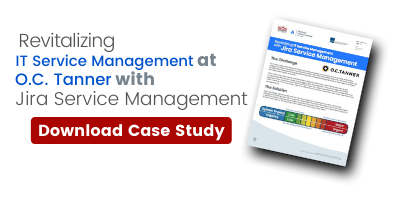Enterprise Service Management is an extension of ITSM. Essentially, companies are recognizing just how valuable and knowledgeable ITSM teams are, and they're calling upon them as experts in managing service desks to share their expertise—and their tools, including JSM—with other areas of the business, like Accounting, Facilities, HR, Legal, and Marketing, etc.
In this blog post, we'll explore a handful of ways teams of all types can benefit from JSM, and how their customers benefit from it as well.
Standardizing Information Collection and Processes
Have you ever called a customer service desk and left a voicemail, then felt completely in the dark about whether anyone would listen to your voicemail or return your call...or if your request would get lost in the shuffle? I think we've all been there!
Many teams don’t have the right tools to intake customer requests, much less triage, respond and resolve them, or the tools they do have don't help them much. Now, imagine if that customer service team had Jira Service Management, just like their IT counterparts. They could leverage its portal functionality, including custom fields, to standardize the intake of common types of requests, as well as the steps that request needs to go through to be resolved. It’s more efficient for the team, because the standardization means they have all the information they need to resolve the issue up front—there’s less back-and-forth with the customer. Every interaction is documented in the history of the ticket, so they don’t have to search through emails for information, and they can even send out notifications to the customer letting them know their request was received and was being addressed.
Issues get resolved more quickly, everything is visible and traceable, the customer knows what's going on, there's less back-and-forth, and fewer things fall through the cracks!
Keeping Customers Informed
It's not enough to let customers know that their request or ticket has been received. They need to be kept up to date as the ticket is being resolved, too. No one likes to have to send (or receive) one of these emails: "Hey, I sent this email three days ago. Why haven't you acted on this?" especially if they’re hard at work on the issue and just haven’t had a chance to get back to the customer. Jira Service Management’s portal is designed so users can actually go into the system and see updates and information, including:
- The request’s position in the queue
- Working status
- Discussions with the agent
In this scenario, if users need to continue the conversation, they won’t use email. They’ll use the portal because they know somebody on the other side will see it. And that creates a stronger feedback loop between the agent and the people raising the issues.
Enabling Self-Help Solutions for Customers
Jira Service Management includes a knowledge base that supports self-help functionality so customers can get answers to common questions or help with easy-to-resolve issues. The way it works is that the team creates articles in the knowledge base that include answers to common questions and explanations for how to resolve simple issues. As the user is typing in what their problem is, the system actually looks up key words against the documentation that’s in the knowledge base and it provides it to the customer. This means customers can get answers to many questions much more quickly—the information they need is literally right at their fingertips—and eliminates the need for someone on the team to have to be hands on in addressing it.
Measuring Deflection
How can you tell if customers are using the knowledge base instead of submitting tickets? That’s where the concept of deflection comes in. Deflection means you opened the portal, raised a request, and found a knowledge base article that answered the question. When teams first start using the JSM, that number will be low, but it will grow over time, and JSM even has reports that can be pulled to measure it. Growth in deflection means that as more standardized requests come in, you're coming up with articles that people can use to get answers to their questions or solve their own issues. Customers, whether they’re internal or external, get what they need faster, which frees up time for the IT or business team to work on bigger or more complex things.
We always tell clients to watch that deflection number over time. If you're using a knowledge base and you don't see that number start to grow, then perhaps your requests aren't formatted properly on the front end or you need to add some new request types.
Centralizing Information
Another key benefit is the aggregation and centralization of information. With JSM, if someone in your organization goes on vacation, the information is still there and visible to the entire team. Everything comes in sorted, categorized, and prioritized, so anybody can assist, and notes on a particular issue are accessible so anybody can step in and help solve a problem.
Having all the requests and related information in one, centralized system also makes it easy to run reporting, so you can see what requests are most common, which are rare, where your team’s time is going, and how quickly issues are being resolved. You can even identify larger, organizational issues that need to be addressed.
On the customer side, the aggregation of data shows up as back-and-forth discussions with the agent. But agents filling these requests, and anyone with back-end access, also have access to this history. You can see comments to the customer, but you can also see internal comments for other members of your team or other teams that are involved.
When you start to see similar requests, you can reuse solutions. And it provides a kind of handoff mechanism, even for single issues. If the agent who's working on it is not available, somebody else can take it and work through those issues properly. In other words, traceability and reporting can create warm fuzzies for the customer.
Measuring Customer Satisfaction
Once a team has Jira Service Management is up and running, they should be able to work much more efficiently—and customers should be experiencing the benefits of that and be happier with the service their receiving. JSM actually includes built-in functionality to measure customer satisfaction through surveys that can be sent out once an issue is closed. The customer can rate the interaction from one to five and explain whether or not their needs were fulfilled.
If you start to see a bunch of ‘one-star’ reviews coming in, you know you have a process problem, or that you've set your portal up wrong. When you're successful, however, you’ll start to see fours and fives on the scores. You can also compare those metrics in the customer satisfaction surveys to any service level agreements you might have established and begin to see what areas you can refine to make the process even more efficient and your clients even happier.

Customizing JSM to Make Teams More Efficient
Jira Service Management is highly customizable and scalable, which is important, because no two teams are alike. This flexibility is part of the reason it works so well for ITSM as well as business teams. At Isos Technology, we love to come in and help our clients build a service desk that works for them today and set the foundation for a service desk that will work for them in the future as well, because as their business grows, their service desk will need to scale.
The goal is always happier customers, whether they're internal or external to the organization. JSM helps teams of all types achieve that by removing the ambiguity, increasing efficiency, and making everything transparent, both to the team manning the service desk, and to the customer.
Sign up to receive more great content
Learn more about Atlassian and how Isos can help by signing up to receive our latest blogs, eBooks, whitepapers and more.














